Aquaponics is a sustainable method of raising both fish and vegetables. Indoor Aquaponics systems form a type of agriculture (aquaculture) that combines raising fish in tanks with soilless plant culture (hydroponics). In aquaponics, the nutrient-rich water from raising fish provides a natural fertilizer for the plants and the plants help to purify the water for the fish. Aquaponics can be used to sustainably raise fresh fish and vegetables for a family, to feed a village or to generate profit in a commercial farming venture, year-round, in any climate.
Indoor aquaponics systems are a great example of year-round, indoor farming. It can be done anywhere, providing fresh local food that is free of pesticides, herbicides, and chemical fertilizers. It is safe, easy and fresh! The best part is that you are providing both vegetables and fish for your table. If you have a larger space, this can easily be scaled up to a commercial venture for a market garden and more.
Please note that this site is supported by affiliate marketing which means that a small portion will be paid to maintain this site from any purchases made through it. This in no way affects the price of the products on this page.
Indoor Aquaponics Systems – Benefits
Aquaponics is a completely natural process that mimics all lakes, ponds, rivers, and waterways on Earth. The only input into an aquaponics system is fish food. The fish eat the food and excrete waste, which is converted by beneficial bacteria to nutrients that the plants can use. In consuming these nutrients, the plants help to purify the water. You cannot use herbicides, pesticides or other harsh chemicals in an aquaponics system, making the fish and plants healthful and safe to eat.
Benefits of Aquaponics
- Use 1/6th of the water to grow 8 times more food per acre compared to traditional agriculture
- All-natural fertilizer source from fish waste
- No reliance on mined and manufactured fertilizers as in hydroponics
- Efficient, sustainable and highly productive
- Produce is free of pesticides and herbicides (it has to be or it would kill the fish!)
- Fish are free of growth hormones and antibiotics
- Allows continuous production of food
- Produces both a protein and vegetable crop
- The integrated system is sustainable and earth-friendly
- Eliminating soil eliminates soil-borne diseases
- When combined with Controlled Environment Agriculture, you can grow year ‘round in any climate
Any kind of leafy vegetable can be grown in aquaponics – from lettuce and herbs to tomatoes and cucumbers. The type of fish can include tilapia, catfish, trout, bigmouth bass, barramundi or even shrimp. If you are growing out-doors, cool water fish such as trout would be best. Even goldfish and koi can be used if you want to grow in a small living room set up and are very ornamental.
Methods of Aquaponic Growing
There are a few primary methods of aquaponic growing widely in use today:
-
Deepwater culture
(DWC) or raft based growing uses a foam raft that is floating in a channel filled with fish effluent water that has been filtered to remove solid wastes. Plants are placed in holes in the raft and the roots dangle freely in the water. This method is most appropriate for growing salad greens and other fast-growing, relatively low-nutrient plants. It is also most commonly used in larger commercial-scale systems.

-
Media-based Aquaponics
Media growing involves growing plants in inert planting media such as expanded clay pellets or shale. The media provides both the biological filtration (conversion of ammonia to nitrates) and mechanical filtration (removal of solid wastes) in the same system. Media-based systems are great for home and hobby scale systems so you can grow a wide variety of crops. In particular, large fruiting plants do really well in addition to leafy greens, herbs and other varieties.
-
Nutrient Film Technique
(NFT) NFT systems work by flowing nutrient-rich water through a narrow trough, such as a PVC pipe. Plants are placed in holes drilled in this pipe, and the roots dangle freely in this stream of water. This method of growing works very well for plants that need little support, such as strawberries and other herbs. NFT is also a great way to utilize unused space because they can be hung from ceilings above other growing areas.
-
Vertical Aquaponics
One of the greatest aspects of aquaponics is its ability to grow an incredible amount of food in a very small area. No method does this better than vertical aquaponics. Plants are stacked on top of each other in tower systems. Water flows in through the top of the tower and flows through a wicking material that the plant’s roots absorb water and nutrients from. The water then falls into a trough or directly into the fish tank. This form of agriculture makes the most of each square foot of space and works very well with leafy greens, strawberries, and other crops that do not require support to grow.
The Sky is the Limit!
The size of your aquaponics system is only limited by the amount of space you can devote to it. Much has been done in unused basement spaces. Check out the following video that shows a large, commercial, greenhouse aquaponics grow and then watch them take it down to a $75 DIY project for at home!
Home Aquaponics Systems
Whatever you do, do NOT buy tiny aquaponics systems that look like either of these:
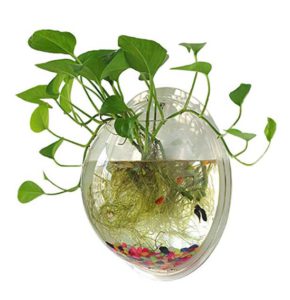
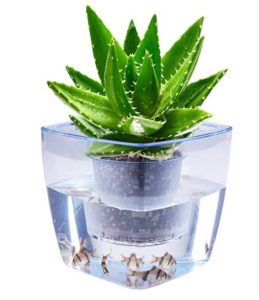
These units, although available at Amazon, provide no aeration for the fish, not enough space for the fish and no aeration for the plant roots. First of all your fish will die and then shortly thereafter, the plant. They look cute but they most certainly do NOT work! Fish need at least a 10-30 gallon aquarium for optimal health and an air stone to keep the water aerated or you’re just looking to kill fish (not to mention the plants)!
Joyfay Aquaponic Fish Tank- Fish Tank, 3.2 Gallon, Hydroponic Cleaning Tank, Fish Feeds The Plants and The Plants Clean The Tank
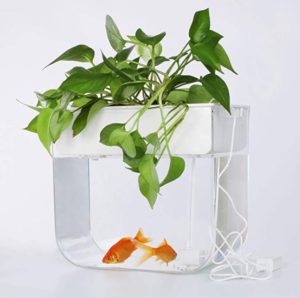 The Joyfay Self Cleaning Fish Tank is an easy clean fish tank that requires very little effort on your part. This is the kind of fish tank you dream about when you’re stuck with a tank that needs to be cleaned frequently. If you’ve had and cared for fish before, you already know what a tedious and time-consuming task it can be to clean a fish tank. This state of the art fish tank integrates the hydroponic growth of plants into the filtration system.
The Joyfay Self Cleaning Fish Tank is an easy clean fish tank that requires very little effort on your part. This is the kind of fish tank you dream about when you’re stuck with a tank that needs to be cleaned frequently. If you’ve had and cared for fish before, you already know what a tedious and time-consuming task it can be to clean a fish tank. This state of the art fish tank integrates the hydroponic growth of plants into the filtration system.
Normal filters don’t always pick up all the grime left behind by the fish, causing you to have to clean the tank periodically. This hydroponic filtration system cycles the dirty water from the tank to the roots of whatever plant that is growing. Whatever you have growing on the top of the tank will then pull all of the dirty substances from the water and use it as nutrients. The water doesn’t get dirty from the fish waste since that’s used to fertilize the plants.
This kind of tank is perfect for fish and can grow many different kinds of plants. Some plants that work well are green onions, bamboo, and basil. Plants, aquarium rocks, and fish are sold separately. They can be purchased at your local pet store and garden center. One year guarantee included.
Here is what one commenter thought about this unit:
The filter is super loud if you open it all the way but I contacted the seller (they got back to me super fast) who said to only open it halfway and that has worked out well. Rinse the pebbles before you add them or you will have a dusty mess in your water. Get a pipe cleaner to help clean the tube part of the filter or else you can’t get in there. I give my fish ” breaks” during the day and turn it off at night– the current can just be a little much for them to have it running all the time. Speaking of giving your fish some “shelter” like the floating log in my tank also gives them some reprieve. My fish hangs in there a lot. The last thing, there are minimal to no instructions and they are in Japanese. It’s not hard to figure out though by looking at the pictures on Amazon. For the most part, it’s pretty low maintenance and the fresh wheatgrass has been great! I’m going to try herbs this winter.
Click HERE to see more.
Pros:
- Cute little system that will fit on your counter
- Compact
Cons:
- Not large enough for big plants but will work well for short leafy vegetables and herbs
- Has no light source so it should be put by a window or supplemented with an LED light.
Darlene’s Opinion: I think this would be a great little system to educate your children with. I would consider growing microgreens in this.
AquaSprouts Garden
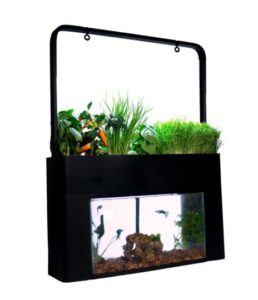 The AquaSprouts Garden is a self-sustaining aquarium & aquaponics kit for the home, office or school. You can grow a variety of veggies, herbs, greens and decorative plants all year long. This is updated model includes adjustable drain extenders to quiet water flow.
The AquaSprouts Garden is a self-sustaining aquarium & aquaponics kit for the home, office or school. You can grow a variety of veggies, herbs, greens and decorative plants all year long. This is updated model includes adjustable drain extenders to quiet water flow.
Click HERE to find out more.
Pros:
- A removable light bar to which you can affix any standard light fixture of your choice. This way you aren’t stuck with using a fluorescent fixture but can upgrade to a decent quality LED light which will give your plants the needed full spectrum of light.
- The kit includes a submersible 9.5 Watts / 120 V 160 gallons per hour pump. Along with a 24-hour timer that can be set for 15-minute intervals. Both the pump and timer include a 1-year warranty.
- Clay grow media replaces soil from traditional gardening and serves as the support for your plants in the grow-bed. They also provide a surface area for the bacteria to grow and convert the fish waste into nutrients for your plants. The grow media traps fish waste and uneaten fish food– making the grow-bed a mechanical filter.
Cons:
- Need to buy a separate 10-gallon fish tank
- Does not come with lights but I actually think this is a pro (see above)
- Rather small
Darlene’s Opinion: I’m surprised at the Amazon rating as most comments were absolutely glowing. However, since this only fits a 10-gallon tank, the growing space will be limited. This could be good if you only have limited space but negative if you want to grow more.
Ecolife ECO-Cycle Aquaponics Indoor Garden System with LED Light Upgrade
 Grow fresh organic produce all year long on your 20-gallon fish tank with no water changes. Fish fertilize the plants. Plants clean the water for the fish in this closed-loop, sustainable system. Advanced, programmable LED lights help your plants grow faster using less energy. 4 grow settings, remote control, and built-in timer give you the most efficient, easy to use system available. Instructional videos, email and phone support included. Water pumps into the aquaponics section of the setup, It goes through the sponge filter into the biological section which then flows through the plant roots, back into the tank.
Grow fresh organic produce all year long on your 20-gallon fish tank with no water changes. Fish fertilize the plants. Plants clean the water for the fish in this closed-loop, sustainable system. Advanced, programmable LED lights help your plants grow faster using less energy. 4 grow settings, remote control, and built-in timer give you the most efficient, easy to use system available. Instructional videos, email and phone support included. Water pumps into the aquaponics section of the setup, It goes through the sponge filter into the biological section which then flows through the plant roots, back into the tank.
Click HERE to find out more.
Pros:
- This is a larger unit so will support more plants.
- It comes with LED lights instead of crappy fluorescents.
- Larger size aquarium will support underwater plants
Cons:
- As with the other units you need to buy or already have a 20-gallon fish tank
Darlene’s Opinion: Of the three options, to me, this is the best and most complete setup. I also prefer the larger size so as to grow more plants. The comments were all very glowing and I agree with them.
Crazy Darlene’s Large Aquaponic System
Unfortunately, the above units really don’t grow a whole lot of plants. If you are looking for a system that will grow a decent amount of plants then check out the WePlant or DreamJoy systems on my previous blog on Best Indoor Hydroponics Systems. Rather than using a Rubbermaid reservoir as per my suggestions there, use a 40-gallon fish tank. You will get the same water filtration from the plants as described in the units above but will get the all-natural fertilization of the fish. This takes a bit more of a DIY touch but is totally do-able. To me, this is the easiest way to grow a large amount of produce aquaponically using prefab materials.
Conclusion
Indoor Aquaponic systems are truly the best of two worlds – aquaculture and hydroponics. Soilless growing systems are becoming more important because they grow food many times faster than soil-based systems and consume much less water. Recirculating systems also protect our environment from Nitrogen and Phosphorous pollution. With urban sprawl growing, we need to come up with alternative solutions to grow healthy food for our families and to reduce our carbon footprint on the planet. With these solutions, you can feed your own family or go large and create a commercial enterprise. The sky is the limit and the choice is yours!
Please leave your comments and questions below! I love them and they also give me ideas for more articles so don’t be shy! Don’t forget to follow for upcoming articles.
Conventional vs. Organic Hydroponic Nutrients

0 (0) Are “Organic” nutrients really better for your system or for your customers? Find out in this video from…
Can You Profit From Hydroponics?
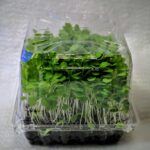
5 (8) Did you hear the story of a farmer who started growing strawberries? Yes? But, do you know he…
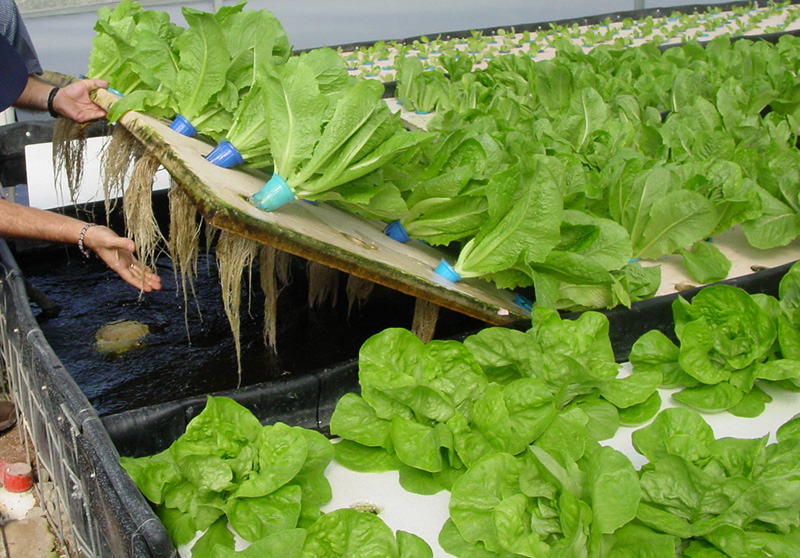
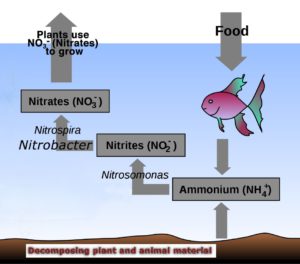

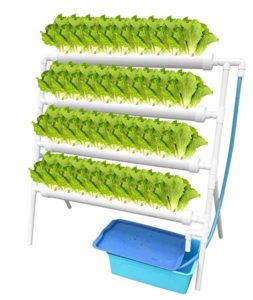

Wow! This is another grey post centered on enriching knowledge about the developments in the world of gardening and planting. Though I know of hydroponics and I run that at the moment, I never knew about aquaponics but reading it here, I think it makes sense combining the features of aquaculture with hydroponics. Wow! I will definitely bookmark this and try it out. But anytime I have problems along the line, can I always comeback to seek your help?
You can ALWAYS come to me with questions, Ro! My e-mail addy is in the Privacy Page if nowhere else – don’t hesitate to use it. I love to hear from fellow people that are into food sustainability!
Aquaponics sounds really interesting. I imagine you would have to get a large fish tank to grow veggies on top. This is very appealing to me because I like homegrown vegetables. The more pesticide or chemical free they are the better it is for my family.
What I think I will do right now is by one of the fish tanks that you have on your website, use my fish to grow some indoor plants. See how that goes. If it goes well then I might look at doing something in a larger tank. Thanks for the great idea.
I already own a fish tank which has two fish swimming in there already. It’s time to change their fish tank as they seem to have outgrown it in the last 10 years. Perfect start to their new home.
Hey, Jagi – make those fish start pulling their own weight and helping you grow food! Little slackers! LOL Thank you for your comments!
This system makes so much sense. Watering with traditional growing is a huge part of the time, energy, cost, and success / yield. The tiny systems look like they would be great and fit in about anywhere, but it’s good that you point out that it isn’t a suitable environment for the fish or the plants! Nobody wants to waste time or money on something that will not be effective!
Thanks for your comments, Aly! Yeah, I’m really against suffocating fish to death – Ewwwww!
You’ve convinced me Darlene!
Especially after watching Drew Hopkins and John Parr’s beautiful system. I’ve done it before when I was younger but in a smaller scale of course but after finding out that it can grow that big and into a business even, I’m psyched to try it all back again! I love the natural system of whereby the plant and fish depend on one another and no pesticides are needed, its easy and in a way, we’re giving back to earth too 😀
I’m so glad I was able to encourage you, Riaz! We really are giving back to the earth, too, as we aren’t buying from the stores where the food is being trucked in from long distances so we are reducing our carbon imprint upon the earth. Not to mention just plain old healthier and more sustainable food!
Wow this is cool. Fish and vegetables could almost be a complete meal. Thanks for mentioning the flaws with those very small units because that is sad that people put the fish in such small containers. Fish are alive to and they need to have a good quality of life. I like what you said about 10 to 30 gallons and an air stone.
Does this create a smell if you have it inside?
Hi Charles, thank you for your comments. Actually, with these systems you won’t even have to clean the fish tanks as often as you would if you were just having fish in tanks. The plants completely filter the water while they are getting the nutrients from it and return perfectly drinkable water back to the tank. Because of this it is totally odorless. Have fun!
Great information and very well written. It was written in a way that anyone reading would understand and it keeps you engaged.
I have always been interested in Aquaponics. I have never tried it, myself, have always wanted to. I have seen the small systems, you mentioned, on Amazon, they have always looked cool and I have thought about buying one. I am glad I n ever did, I do not want to buy a small system because it looks cool, just to kill a fish.
I am interested, now, in trying a larger system. Thank you for the information.
Hiya Myrna! Well, the two 10 gallon units that I mentioned wouldn’t take up a HUGE amount of room. I think they might be perfect starter units and would actually grow a reasonable amount of food rather than just being decorative – although they are that, too!
I have always wanted to start my own aquaponics system at home. The benefits are numerous as you pointed out. It’s a system that is beneficial for so many reasons and it can be housed in any home. A system like this will also pay for itself very quickly because you would pay a fraction of the price for the produce then you would at any supermarket. For all of these reasons and more I will be installing this system at home right away.
I’m so glad you like this, Rina! I just love how the fish and plants both sustain each other. What a perfect synergy. I wish you all the best in your aquaponic adventures!
Wow, what a great concept! My wife has always pressured me into growing this huge garden outside, but who has the time or energy to deal with all that. These Home Aquaponics systems are a great alternative, as they are way more manageable and less stressful to grow fresh produce from the comfort of your own home. I will definitely consider these and pass this idea along to others. Thanks again for this post!
Awwwww – thank you, Chris, for the kind comments. I hope that you give it a try and do enjoy!
I have heard about this method before but I didn’t know that it’s termed as Aquaponics. I think setting up your own aquaponics system will be beneficial for the family and can give extra income if propagated. Maybe start with an aquarium just to see how things would go in your hands. We have a small backyard where we plant some crops and leafy vegetable. It’s not really big but I think it’s a good project to have an aquaponics like a Deep Water Culture or Vertical Aquaponic because of the small area we have.
This is also a good suggestion for a school project. The school where my kids go into are advocates of clean and green surrounding and plastic free environment. They have an eco park inside where different plants are maintained by students themselves. Bringing aquaponic into the office and at home is also a great idea. What I like best is the Aquasprouts garden. It looks definitely good for display, very relaxing to look at and of course a nice contribution to the ecosystem (in a posh way). Thank you, Darlene! It was nice of you to share it with us.
Hi MissusB – I couldn’t agree more. Start small and get a feel for it before you put the time and money into something larger. If you do decide to use some of your outdoor space for aquaponics might I suggest you go to YouTube and look up aquaponics systems there? I swear there were about 10 videos I wanted to put on this page! Its amazing what can be done in a small outdoor space, depending on climate.
Starting my own aquaponics system at home has always been a drive for me, the benefits associated with it are simply huge just like you have pointed out in this post. I love the flexibility associated with it and can be housed anywhere. Surely, the fact that one would get healthy product results would make this an additional bonus rather than going to buy less nutritious produce. Though I will be very limited in running this myself, I have a cousin who is into gardening full time, I will suggest this post to her and hopefully, she finds it very interesting to take on. Great post
Rodger
Thank you for your comments, Rodger. I wish you and your cousin well in this. I think you’ll have a lot of fun along the way!
Hello Darlene.
I am surprised there hasn’t been more publicity on this type of growing.
It looks healthier and more affordable than what you can purchase in the store. Plus you get to grow some healthy eating fish. Some of the lakes I have lived near have had signs posted informing you not to eat certain types of fish more than once a month. Really, what’s up with that, good old pollution.
I love your website, very informative and I am going to share with my sister in Montana. Her and her husband live on 95 acres. She likes to produce her own vegetables for cooking. They also produce their own beef, eggs, butter and not sure what else.
Thanks for developing and sharing.
Hiya Mike! You are too right. Its amazing how few people use this type of agriculture. I mean, who doesn’t like fresh fish and veggies? I hope that your sister finds the information to be of use!
How much more conviction do I need to be fully assured that aquaponics is awesome and something I can venture into. I personally love home grown vegetables and juxtaposing plants and fishes together is a totally perfect idea. I think I’ll just get one of this tanks and get on the way. Thanks for the educative post
Thank you, Henderson! You’ll never look back if you do – its a perfect combo!